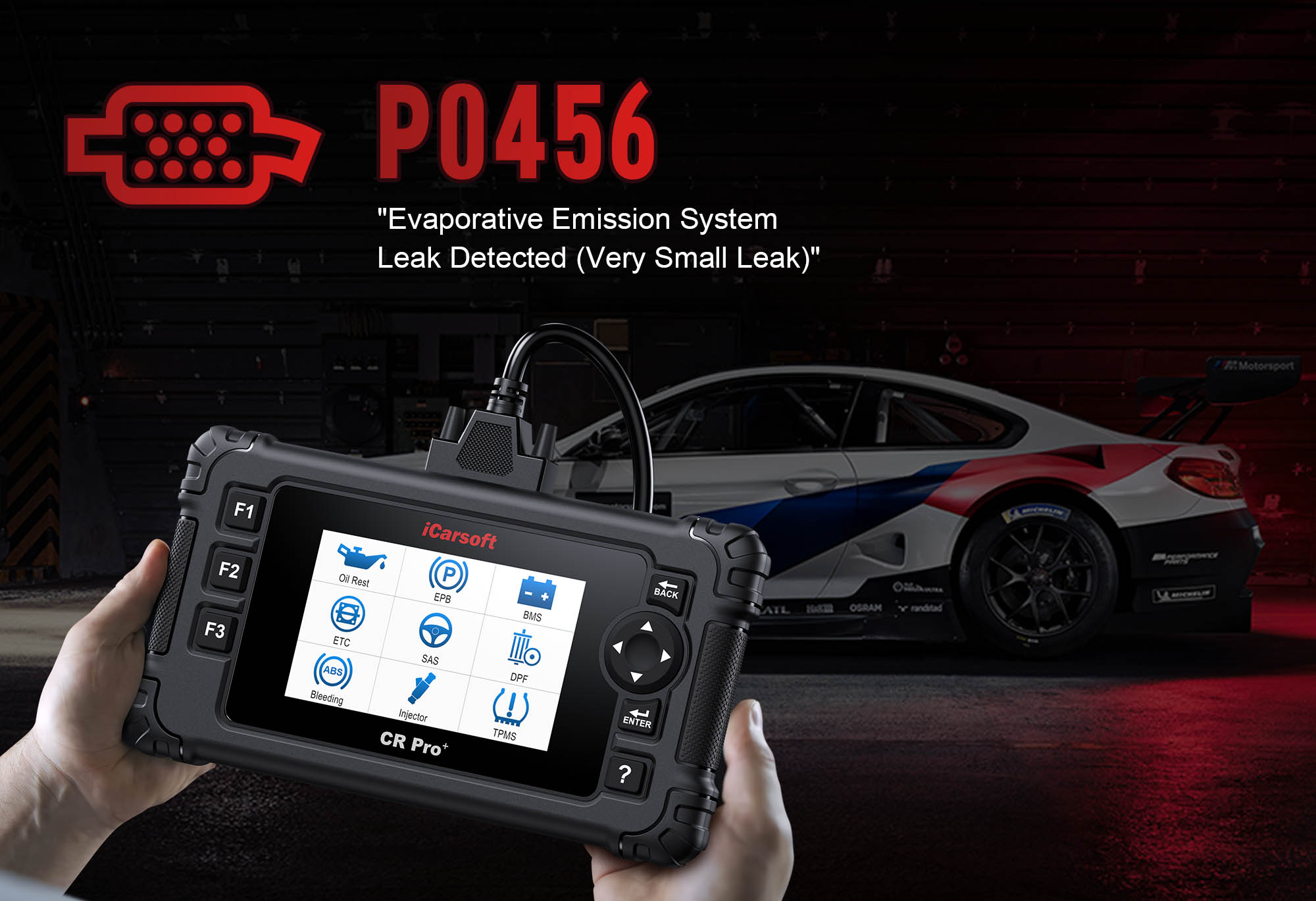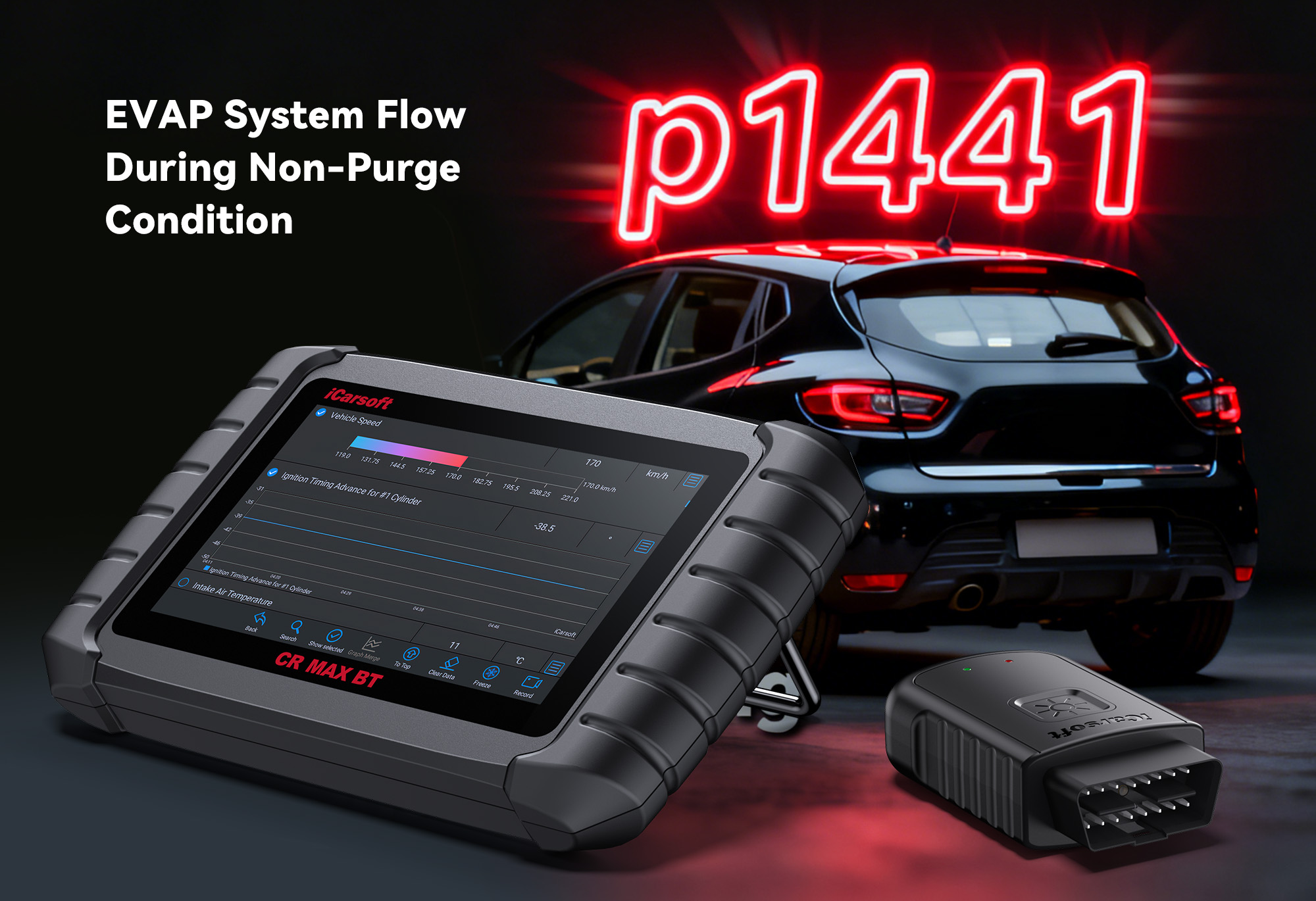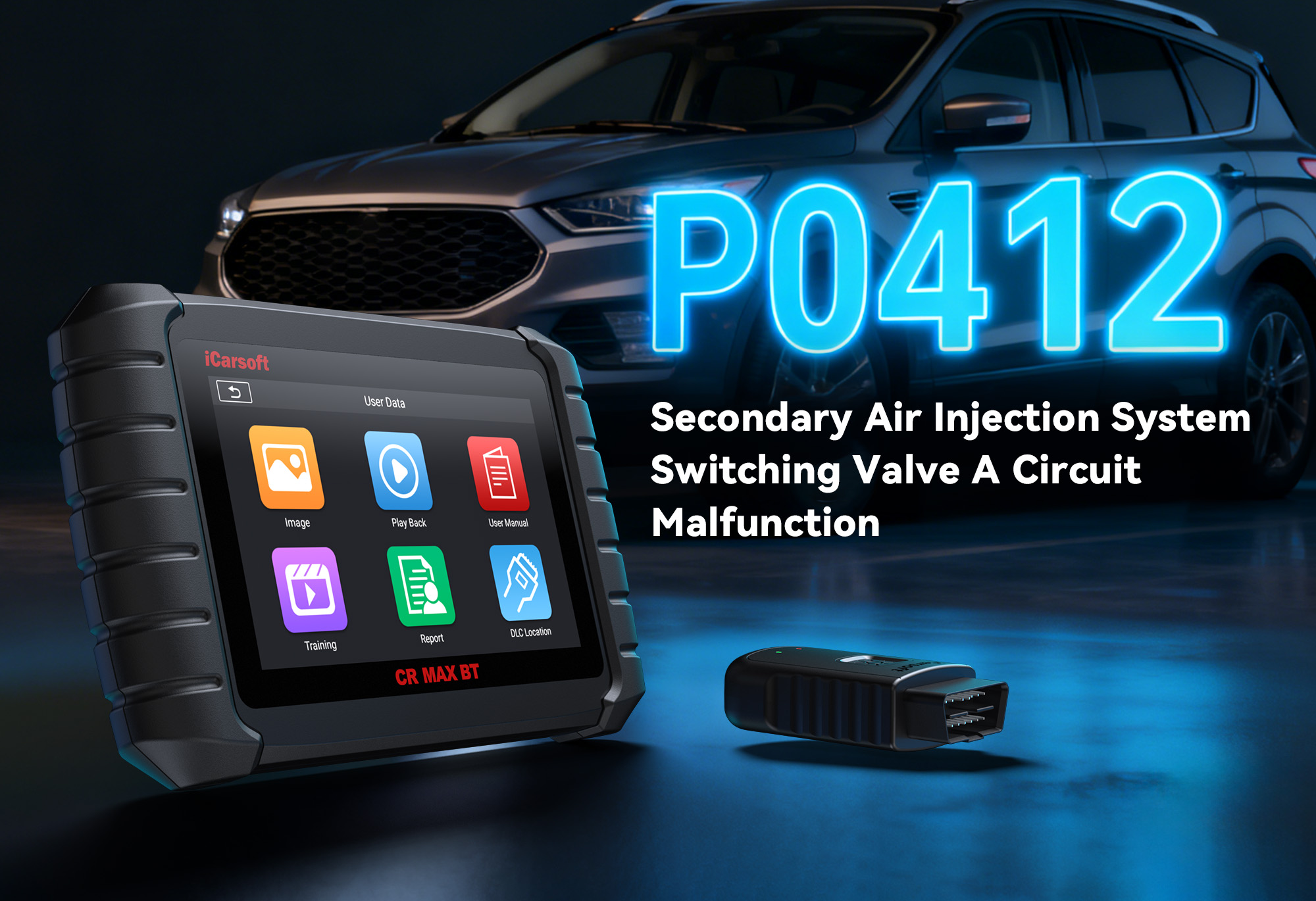Diagnose & Clear P0456 with iCarsoft CR Pro+: Fix EVAP System Small Leak Issues
If your check engine light flickers to life and a scan returns P0456, your vehicle’s Evaporative Emissions (EVAP) system is signaling a subtle but important issue. This generic OBD-II code stands for "Evaporative Emission System Small Leak Detected"—meaning the Engine Control Module (ECM) has detected a tiny breach (typically 0.020–0.040 inches) in the EVAP system, which captures and recycles fuel vapors to reduce environmental impact.
Unlike the larger leaks flagged by P0455, a "small leak" in P0456 is often harder to spot but no less critical. The EVAP system relies on a tight seal to trap gasoline vapors in a charcoal canister, later recycling them into the engine for combustion. Even a pinhole-sized leak allows these vapors to escape, triggering emissions warnings, reducing fuel efficiency, and potentially causing failed state inspections.
Basic scanners might only label P0456 as a "minor EVAP leak" but lack the precision to locate tiny cracks or worn seals. The iCarsoft CR Pro+—with its advanced pressure testing, EVAP-specific diagnostics, and professional-grade leak detection—solves this. Let’s walk through how to diagnose and resolve P0456.
Why It Matters
Ignoring P0456 may seem harmless due to its "small leak" label, but it carries hidden consequences. Escaped fuel vapors contribute to air pollution (violating emissions standards) and waste fuel—even a 0.020-inch leak can reduce gas mileage by 1–3% over time, adding up to extra costs at the pump. For vehicles in emissions-testing states, P0456 guarantees a failed inspection, requiring re-tests and potential fines until resolved.
Worse, small leaks often worsen with temperature changes (expanding/cracking hoses) or vibration (loosening clamps), eventually leading to larger EVAP faults (e.g., P0455 for major leaks). Addressing P0456 early with the CR Pro+ prevents costly repairs later—avoiding charcoal canister replacement ($300–$800) or solenoid failure ($150–$400).
Understanding P0456: Causes & Key Symptoms
To tackle P0456 effectively, first recognize its unique traits compared to larger EVAP leaks—this helps narrow down the root cause quickly:
Key Symptoms of P0456
-
Intermittent Check Engine Light: Often illuminates after refueling (pressure changes) or temperature shifts (expanding/cracking hoses), then may turn off temporarily—hiding the issue from basic scanners.
-
Subtle Fuel Odor: Faint gasoline smell near the rear of the vehicle (not as strong as P0455’s noticeable fumes) – easiest to detect when the tank is full.
-
Failed Emissions Tests: Even tiny vapor leaks push hydrocarbon (HC) levels above legal limits, leading to automatic test failure.
-
Reduced Fuel Efficiency: Unrecovered fuel vapors decrease mileage by 1–3%—a small drop that’s hard to notice immediately but adds up over months.
-
No Major Performance Issues: Unlike engine-related codes, P0456 rarely causes rough idle, power loss, or stalling—making it easy to overlook without a scan.
Common Causes of P0456
|
Cause
|
Description
|
|
Worn Gas Cap Seal
|
Dried-out, cracked, or debris-clogged rubber gaskets on the gas cap—responsible for 25% of P0456 cases. Fails to seal the tank, allowing vapor escape.
|
|
Pinholes in EVAP Hoses
|
Age, heat, or rodent nibbles create micro-cracks in flexible hoses connecting the gas tank to the charcoal canister—leaks worsen with temperature changes.
|
|
Loose Hose Clamps
|
Over time, vibration loosens clamps securing EVAP hoses to components—creates small gaps that leak vapors, especially during driving.
|
|
Charcoal Canister Degradation
|
Fine cracks in the canister (from corrosion or undercarriage impact) release vapors—internal carbon bed damage may also reduce vapor retention.
|
|
Faulty EVAP Valves
|
Worn seals in the Purge Solenoid (engine-mounted) or Vent Solenoid (canister-mounted) allow slow pressure loss—common in vehicles over 5 years old.
|
|
Fuel Filler Neck Gasket Wear
|
Deteriorated rubber gaskets where the filler neck connects to the gas tank—leaks occur when the tank is full (higher pressure).
|
Why iCarsoft CR Pro+ Excels at Diagnosing P0456
The CR Pro+ outperforms basic scanners with precision features tailored to small EVAP leaks—critical for P0456, where even 0.1 kPa pressure changes matter:
High-Resolution Pressure Monitoring
Measures pressure fluctuations as small as 0.1 kPa—detects leaks too subtle for standard scanners (which often miss changes under 1 kPa).
Enhanced EVAP Leak Test
Runs a 15-minute pressurized test (vs. 2–5 minutes on basic tools) to capture slow, intermittent leaks that only appear over time.
Smoke Test Integration
Compatible with professional smoke machines via its auxiliary port—visualizes tiny leaks in hoses, canisters, or solenoid seals.
Vehicle-Specific EVAP Maps
Preloaded with detailed diagrams for 65+ makes (BMW 3 Series, Audi A4, Jeep Wrangler)—highlights common leak points for your vehicle.
Canister Purge Volume Tests
Calculates vapor flow through the charcoal canister—identifies internal degradation that basic tools can’t detect.
Historical Data Logging
Records pressure changes over hours—captures intermittent leaks that appear only during temperature shifts or driving.
Step-by-Step: Diagnose P0456 with iCarsoft CR Pro+
-
1. Connect & Confirm the Code
1. Plug the CR Pro+ into your vehicle’s OBD-II port (under the dashboard) and power it on.
2. Select your vehicle via Auto VIN Scan (reads your VIN in 2–3 seconds) or manual entry (make/model/year—critical for EVAP system specificity).
3. Navigate to Engine > Fault Codes > Read Codes to confirm P0456. Tap Code Details for vehicle-specific insights (e.g., "BMW: EVAP Pressure Drop >0.5 kPa Over 10 Minutes" or "Jeep: Small Leak in Tank Vent Circuit").
-
2. Check for Related EVAP Codes
P0456 rarely appears alone—scan for companion faults to narrow the root cause:
- P0440: General EVAP Malfunction (systemic wear, e.g., aging hoses + solenoids)
- P0442: Small Leak (model-specific variant of P0456)
- P0446: Vent Solenoid Fault (seal failure causing slow leaks)
- P0452/P0453: EVAP Pressure Sensor Low/High Input (faulty sensor masking leaks)
Multiple codes = address systemic issues, not just one component.
-
3. Inspect the Gas Cap First (25% of P0456 Cases)
The gas cap is the most common culprit—use the CR Pro+ to verify:
1. Remove the gas cap and inspect the rubber gasket for cracks, dryness, or debris (wipe clean with a damp cloth if dirty).
2. Tighten the cap until you hear 3–4 clicks (proper sealing position).
3. Navigate to Special Functions > EVAP > Gas Cap Seal Test—the CR Pro+ runs a 5-minute pressure test.
4. Results:
- Test passes = cap is good; move to other components.
- Test fails = replace the cap with an OEM part (use the scanner’s Part Lookup for specs, e.g., Toyota 77300-0C040).
-
4. Run the Enhanced EVAP Leak Test
Use the CR Pro+’s precision test to confirm a small leak:
1. Prep the vehicle:
- Ensure gas tank is 1/4 to 3/4 full (extremes disrupt pressure stability).
- Turn off the engine and ensure all doors are closed.
2. Navigate to Special Functions > EVAP > Enhanced Leak Detection.
3. Follow on-screen prompts: The scanner closes the Vent Solenoid, pressurizes the system to 3 kPa, and monitors for 15 minutes.
4. Results:
- Pressure holds steady = no leak (P0456 may be a false code from a previous loose cap).
- Slow pressure drop (0.5–2 kPa over 15 minutes) = small leak (proceed to locate it).
-
5. Locate the Leak with Visual Inspection & EVAP Maps
Use the CR Pro+’s Component Location tool to find key EVAP parts—focus on these common leak points:
EVAP Hoses:
- Trace hoses from the gas tank to the charcoal canister (follow the scanner’s diagram).
- Flex hoses gently to spot light through pinholes; check for loose clamps (tighten with a screwdriver or replace if corroded).
- Squeeze hoses—hard, inflexible sections (dry rot) need replacement.
Charcoal Canister:
- Located near the rear axle—inspect seams for hairline cracks (use a flashlight).
- Check vent valve connections for looseness or cracked O-rings.
Purge/Vent Solenoids:
- Purge Solenoid (engine/firewall-mounted): Check for oil contamination (damages seals) and loose electrical connectors.
- Vent Solenoid (canister-mounted): Inspect the rubber O-ring for cracks (replace if worn).
Fuel Filler Neck:
- Check the gasket where the neck connects to the tank—look for missing pieces or cracks.
-
6. Use Smoke Testing for Hidden Leaks
For elusive leaks (e.g., tiny hose pinholes), pair the CR Pro+ with a smoke machine:
1. Connect the smoke machine to the EVAP system’s service port (location shown in the CR Pro+’s diagram).
2. Navigate to Special Functions > EVAP > Smoke Test Mode—the scanner closes solenoids to seal the system.
3. Inject smoke at low pressure (1–2 kPa)—watch for wisps escaping from pinholes, loose connections, or cracked canisters.
4. Mark leak points with tape—repair immediately (e.g., splice hoses, replace O-rings).
-
7. Test EVAP Valves for Weak Seals
The CR Pro+’s bi-directional tests identify solenoids with worn seals:
Vent Solenoid Test:
1. Go to Special Functions > EVAP > Vent Solenoid Activation.
2. Activate the solenoid (should seal the system) and monitor pressure via live data.
3. Slow pressure drop (>0.3 kPa in 5 minutes) = weak seal—replace the solenoid.
Purge Solenoid Test:
1. Repeat for the Purge Solenoid—select Purge Solenoid Activation.
2. Ensure the solenoid holds pressure when closed (no drop within 5 minutes).
3. Use the CR Pro+’s Part Lookup for OEM replacements (e.g., Bosch 0280142515 Vent Solenoid).
-
8. Repair & Clear P0456
Fix the root cause based on diagnostics:
- Worn Gas Cap: Replace with OEM (avoid generic caps—they often don’t seal properly).
- Pinhole Hoses: Cut out damaged sections and splice with EVAP-rated heat-shrink connectors (resistant to fuel vapors).
- Faulty Solenoids: Swap with OEM parts—torque to specs (5–8 ft-lbs, provided by the scanner).
- Canister Cracks: Use EVAP-specific sealant for small cracks; replace the canister if damage is severe.
- Loose Filler Neck Gasket: Replace the gasket and tighten the neck to manufacturer torque (10–12 ft-lbs).
Clear the code: Navigate to Engine > Fault Codes > Clear Codes to delete P0456 and related EVAP faults.
-
9. Verify the Repair
Confirm the leak is fixed to avoid reoccurrence:
1. Re-run the Enhanced EVAP Leak Test—pressure should hold steady for 15 minutes.
2. Take a 30-minute test drive (include highway and city driving) to let the ECM recheck the EVAP system.
3. Rescan with the CR Pro+—no return of P0456 = successful repair.
4. Check emissions readiness: Navigate to Readiness Monitors—ensure the EVAP monitor is "Ready" for state inspections.
Preventing P0456 Recurrence
The CR Pro+ helps maintain a tight EVAP system long-term, avoiding future P0456 codes:
-
Gas Cap Maintenance: Clean the cap’s gasket monthly with mild soap and water; replace every 3–5 years (set a reminder in the CR Pro+’s Service Scheduler).
-
Hose Inspections: Check EVAP hoses during 15,000-mile services—replace any showing dry rot, cracks, or brittleness.
-
Solenoid Care: Apply dielectric grease to solenoid electrical connectors annually to prevent corrosion (use the CR Pro+’s Component Tips for location guidance).
-
Seasonal Checks: Run the Enhanced Leak Test before extreme temperature changes (summer/winter)—catches expanding cracks early.
-
Canister Protection: Avoid driving over debris or curbs that could damage the undercarriage-mounted charcoal canister.
StepAction1Connect CR Pro+, confirm P0456, and review vehicle-specific code details2Scan for related EVAP codes (P0440, P0446, etc.)3Test gas cap seal with the CR Pro+; replace if faulty4Run Enhanced EVAP Leak Test to confirm small leak5Locate leaks via visual inspection (using EVAP maps)6Use smoke testing for hidden leaks (CR Pro+ integration)7Test Purge/Vent Solenoids for weak seals8Repair root cause and clear P04569Re-test EVAP system and confirm repair with a test drive
Conclusion
P0456’s "small leak" label can be deceptive—it threatens emissions compliance, wastes fuel, and sets the stage for costlier EVAP failures. The iCarsoft CR Pro+ eliminates guesswork with precision tools: high-resolution pressure monitoring to catch tiny leaks, smoke test integration to visualize hidden issues, and vehicle-specific maps to target common fault points.
Whether you’re replacing a $20 gas cap, patching a $5 hose, or swapping a $100 solenoid, the CR Pro+ ensures you fix the root cause—not just mask the code. By following this guide, you’ll turn a frustrating "intermittent check engine light" into a confident repair, keeping your vehicle efficient, compliant, and reliable for years.
FAQs About P0456 Code
Q: Can I drive my vehicle with P0456?
A: Yes, but only temporarily. P0456 doesn’t affect engine performance, but long-term driving allows small leaks to worsen (e.g., cracking hoses) and risks failed emissions tests. Fix it within 1–2 weeks to avoid costly repairs.
Q: Will a generic gas cap fix P0456?
A: Rarely. Generic caps often don’t match OEM sealing specs (e.g., incorrect gasket thickness) and may trigger P0456 even if the original cap was the issue. Use the CR Pro+’s Part Lookup to find an OEM cap—critical for proper sealing.
Q: Why does P0456 keep coming back after repair?
A: Common reasons include: 1) Unrepaired secondary leaks (e.g., fixing a hose but missing a solenoid seal), 2) Using non-EVAP-rated parts (e.g., standard heat-shrink instead of fuel-resistant), 3) Failing to reset the EVAP monitor (drive 30 minutes after clearing codes). Re-run the CR Pro+’s Enhanced Leak Test to find hidden issues.
Q: How much does it cost to fix P0456?
A: Costs vary by cause: Gas cap replacement = $20–$60 (DIY); Hose repair = $5–$30; Solenoid replacement = $80–$150 (DIY); Charcoal canister replacement = $300–$800 (professional). The CR Pro+ helps avoid overspending by identifying low-cost fixes first.





